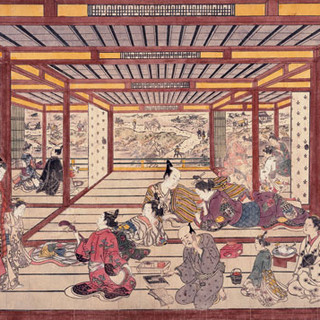Asia's Floating Worlds
- Abby Lu
- Dec 1, 2020
- 3 min read
Comparison:
Show Platforms vs. Paradise Palace vs. Yubaba's Bathhouse vs. Edo Yoshiwara
vs. Kowloon Walled City
As an art history enthusiast, I tirelessly search for connections between pieces. Spotting the influence one type of art exerts on another is bearing witness to a dialogue of ideas and inspiration between two separate souls.
The idea hit me as I delved deep into Baidu to unearth the secrets behind glove puppetry, specifically those originating from Southern Chinese cultures like the Hakka and Taiwanese People. Turns out, glove puppets are not traditionally performed by raising one's hands above a black screen, but on specialised platforms called Show Platforms, or 彩樓 (direct translation: rainbow building). These platforms are often ornate, just like an imperial or holy palace. Small glove puppets meander up and down these palaces during performances, or they jump from one story to another. Overall, these platforms offer a lively setting to the performance.
Due to their ornate and festival nature, these platforms perfectly match the exciting atmosphere during celebrations where glove puppetry is performed.
The layered and ornate platform reminded me of an exhibition I saw last year in the Quai Branly Museum of Paris. The featured piece was called Palace Paradis, by Hsin-Hsin and Skea of Taipei. The piece is reminiscent of the traditional Taiwanese practice of Zhizha (紙紮, direct translation: paper bonding), which are paper crafts resembling mini household objects that are burned as funerary offerings. At as I stood in front of that paper building, enthralled by the colour and uncanny familiarity, I wanted to shrink and live inside this delicate creation.
On another note, these densely packed houses reminded me of the bathhouse in Hayao Miyazaki's 2000 film Spirited Away. I imagine the interiors of the show platform and paradise palace would looking something like that of the bathhouse, with intricate corridors connecting staggered floors. Inside, characters would move freely as if in a jungle, or a beehive. The sheer layers existing within these buildings and the unresting bustles almost force the characters to be constantly connected to one another. At night, I'm sure all the chaos would be unleashed inside the man-made jungle, and events from dreams would take place. Spirits and people would dance together. These spaces would become floating worlds detached from our reality of big, concrete buildings reeking of corporate stresses.
Turns out, a floating world once existed in real life–the Yoshiwara red-light district of Edo Japan (吉原、江戸時代). A nickname for the district was Ukiyo (浮世), meaning floating world. Allegedly, the hierarchies of Edo Japan disappeared within this district as people cast aside everything for one entertaining evening. Samurai would shed their armour and disguise themselves in order to watch Kabuki with the masses. The district was like a dream world existing only at night, or a floating world. The interconnecting chambers lying within must be packed with folklore and scandals that modern humans only dream of. Here, people controlled by societal roles like puppets are free.
The Kowloon Walled City in Hong Kong was once chaotic and the amalgamation of tiny, intricate spaces and worldly affairs. For better or worse, it has been demolished. I still like to imagine the stories that could have been if it still stood to this day. Or rather, the countless untold stories wafting through its dark corridors, forever lost in dusty deterioration. Crawling with crime, the walled city is simultaneously the place with the most and least freedom. On one hand, the city was free from legal surveillance as even the police shrank from its jungles. However, inhabitants are still bound by the pressure of basic survival as they struggle to make a living in this isolated ecosystem.
Tiny worlds. So cool! A better term connecting all five spaces would be floating worlds. They are stuck in liminality between the realms of humans and dreams. Meandering through the long corridors of any one of them would be a dream for modern humans. It's physically impossible to walk in any of them. However, their magic lives on.





















Comments